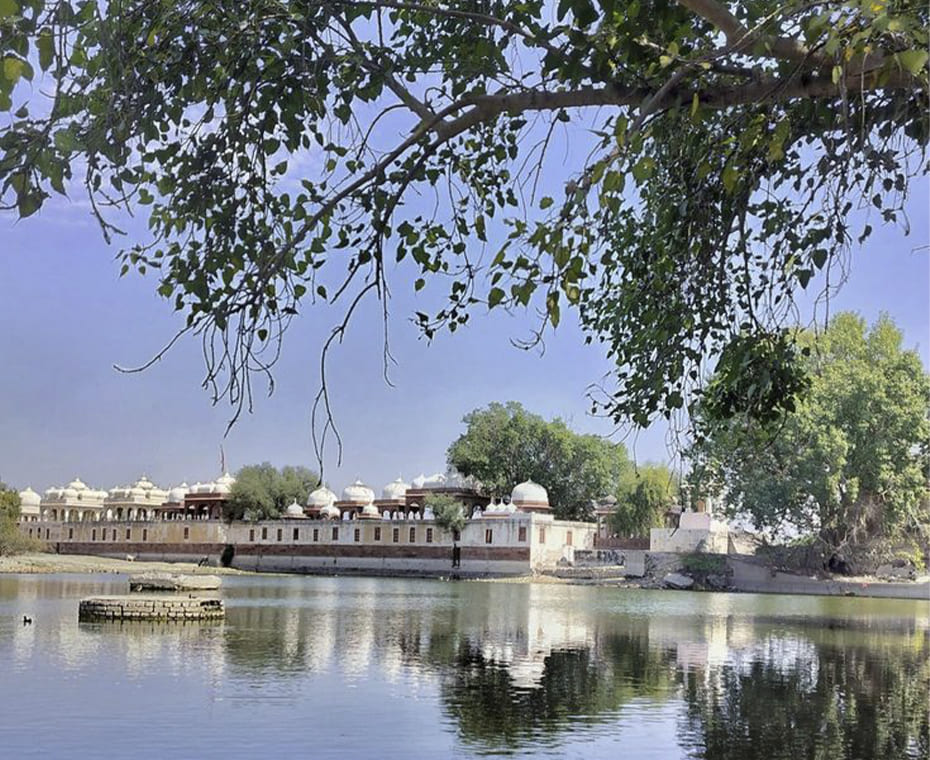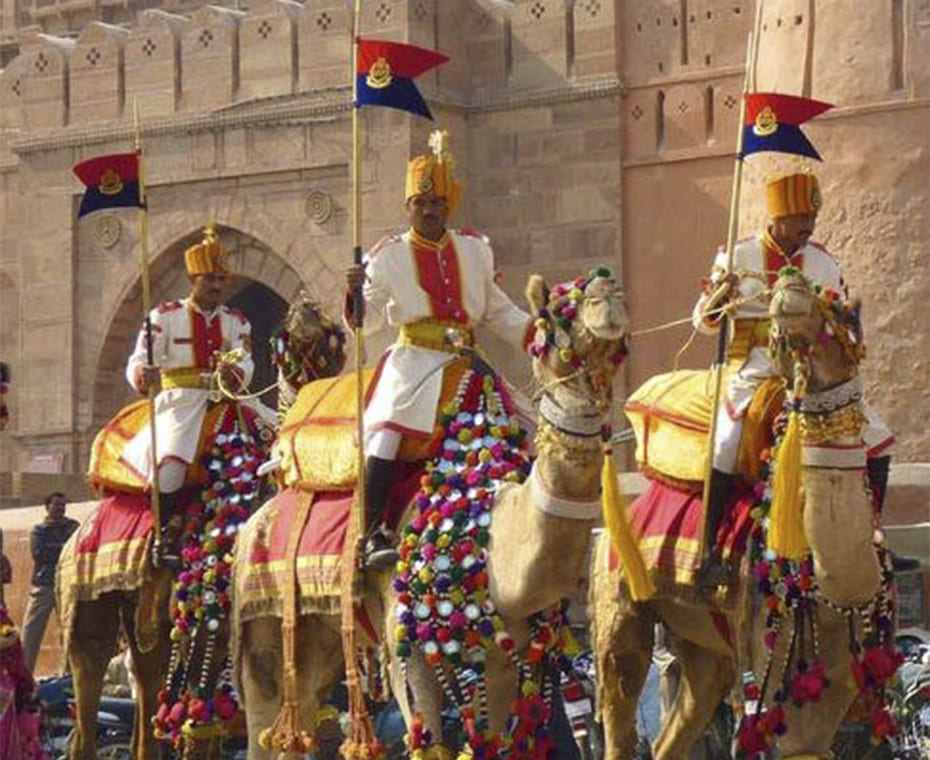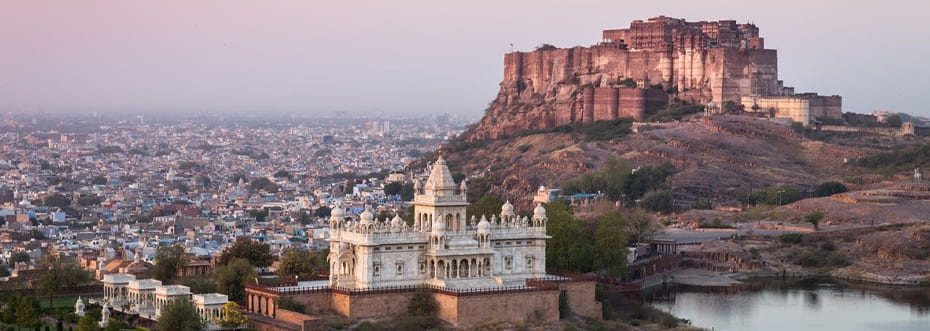




DAY 01 : ARRIVE DELHI
Arrive Delhi, the capital city of India. Upon arrival, you will be met by our representative at the Indira Gandhi International Airport and transfer to your hotel.
Overnight at the hotel.
DAY 02 : DELHI – MANDAWA (270 Km / 6.5 hours)
After early breakfast, proceed to Mandawa a small town which is famous for its forts and havelis which was founded in 1755 by Thakur Nawal Singh and still the home of his descendants has beautiful frescoes.
Upon arrival, check-in at your hotel. Later in the afternoon visit the Mandawa including Murmuria Haveli, Banshidhar Haveli and Gulab Rai Haveli.
Overnight at the hotel.
DAY 03 : MANDAWA – BIKANER (195 Km / 4 hours)
Post breakfast, transfer by road to Bikaner. On arrival, check-in at your hotel.
Bikaner - Rao Bikaji, the second son of the founder of Jodhpur, established Bikaner. The old city stands on a slightly high ground delimited by a fortified wall.
Afternoon proceed to city tour of Bikaner covering Junagarh Fort, Ganga Golden Jubliee Museum and Camel Breeding Farm.
The Junagarh fort was built in the late 16th century by Raja Rai Singh, a general in the army of Akbar, the Mughal emperor. The Fort lodged palaces inside it and many Maharajas added comfortable suites to it.
The museum has been branched into various sections according to the order and historical importance of the exhibits. In this museum, we can see Traditional Rajasthani musical instruments, terracotta ware, the Silk Robe of Prince Salim along with the delicate collection of miniatures from across the desert, antique carpets and royal garments.
Overnight at the hotel.
DAY 04 : BIKANER – JAISALMER (375 Km / 7.5 hours)
After breakfast, transfer by road to Jaisalmer en-route visiting Karni Mata Temple.
The temple is famous for the approximately 25,000 black rats that live, and are revered, in the temple. These holy rats are called kabbas, and many people travel great distances to pay their respects.
On arrival, check-in at your hotel. Rest of the day at leisure.
Jaisalmer was established by the head of the Bhati sect, Rawal Jaisal Singh in 1156 A.D. It is called the golden city of the Thar Desert, because yellow sand and yellow sandstone is used in most of the buildings in the city.
Overnight at the hotel.
DAY 05 : JAISALMER
Post breakfast, start your day to explore the golden city, Jaisalmer covering Jaisalmer Fort, Jain Temples, Laxminath Temples, Havelies and Gadi Sagar Tank.
Jaisalmer Fort was constructed in 1156 by the Bhati ruler, Rao Jaisal. This fort stands over the 80 m tall Trikuta hill, and is delimited by 3 walls and 99 bastions. The Golden sandstone fort over the centuries witnessed many battles between the Bhatis, Mughals and the Rathores of Jodhpur.
Jain Temples constructed in the 12th and the 15th century. There are seven Temples in the complex: Chandraprabhu, Parasnath, Shitalnath, Sambhavanth, Shantinath, Kunthunath and Rikhabdev Temple.
Havelis are the places, which served as the dwelling place of the ministers and the landlords and they commission these Havelis to show their social status in the society. Patwon ki Haveli is the most elegant and palatial of all the Jaisalmer Havelis. This haveli was constructed between 1800 and 1860 by five Jain brothers. Salim Singh ki Haveli and Nathmalki Haveli are the other two havelis that are open to visitors.
Later in the evening, transfer to Sam Sand Dunes to enjoy the Camel Ride & witness beautiful Sunset.
Overnight at the hotel.
DAY 06 : JAISALMER – POKHRAN – JODHPUR (285 Km / 06 hours including sightseeing)
Post breakfast, transfer by road to Jodhpur.
En-route visit Pokaran Fort and also witness Pattu weaving, which is in every home on traditional looms.
On arrival, check-in at your hotel. Rest of the day at leisure.
Jodhpur, the second largest city in Rajasthan, lies at the entrance to the Thar Desert in a region called Marwar which was founded by Rao Jodha in 1459 A.D and also known as 'Blue City' due to the mesmerizing charm of blue houses and structures that one gets to witness when in Jodhpur.
Overnight at the hotel.
DAY 07 : JODHPUR – RANAKPUR – UDAIPUR (275 Km / 5.5 hours)
Morning after breakfast, transfer by road to Udaipur.
En-route visit the famous Jain Temples at Ranakpur. Built in the 15th century, Ranakpur temples are one of the largest Jain temples in India. The temples are known for their architecture, grand structures and exquisite sculptures.
On arrival, check-in at your hotel. Rest of the day at leisure.
Udaipur also known as “Venice of East” and “City of Lakes” was established by a Rajput King, Maharana Uday Singh, in 1567.
Overnight at the hotel.
DAY 08 : UDAIPUR
Post breakfast, visit the 16th century City Palace, one of the largest palace complexes in Rajasthan comprising residence of the current Maharaja, heritage hotels, museums and galleries, courtyards and reception halls where royal events take place even today; Jagdish Temple, the 17th century Indo Aryan temple dedicated to Lord Vishnu (Laxmi Narayan), the preserver of the Universe.Saheliyon-Ki-Bari, garden of the maids of honour, with beautiful green lawns, flower beds, water pools, marble elephants and bird fountains.
Thereafter relax at hotel for some time else you can also visit Monsoon Palace, which is also known as the Sajjan Garh Palace, is a hilltop palatial residence in the city of Udaipur, Rajasthan in India, overlooking the Fateh Sagar Lake, The palace offers a panoramic view of the city's lakes, palaces and surrounding countryside. It was built chiefly to watch the monsoon clouds; hence, appropriately, it is popularly known as Monsoon Palace.
Evening enjoy the boat ride on Lake Pichola.
Overnight at the hotel.
DAY 09 : UDAIPUR – PUSHKAR (280 Km / 5.5 hours)
Post early breakfast proceed for Pushkar, the home to the only temple dedicated to Lord Brahma in the world and also known for Pushkar camel Fair or world's largest cattle fair.
Apart from the buying and selling of livestock, it has become an important tourist attraction. Competitions such as the ‘matka phod’, ‘longest moustache’ and ‘bridal competition’ are the main draws for this fair which attracts thousands of tourists.
Upon arrival check-in at your hotel. Later proceed to visit Pushkar, its temple & a colourful vibrant market.
Overnight at the hotel.
DAY 10 : PUSHKAR – SANGANER – JAIPUR (160 Km / 07 hours including sightseeing)
Morning post breakfast, transfer by road to Jaipur. En-route visit Bagru & Sanganer.
Sanganer is renowned for its crafts and hand-printed textiles. The town of Sanganer is well known as the largest center of the handmade paper industry. It manufactures the supreme quality of handmade papers and hand printed textiles by using units of block and screen printers.
On arrival, check-in at your hotel. Rest of the day at leisure.
Jaipur - land of the Rajput’s. Jaipur is the capital of Rajasthan, and is known as the “Pink City” because of the pink-tinted constructions in the old city. Recently the walled city of Jaipur has joined the elite list of UNESCO World Heritage Sites.
Overnight at the hotel.
DAY 11 : JAIPUR
After breakfast, proceed to city tour of Jaipur and Amber. Sightseeing includes Amber Fort, Fort is located 11 km away from Jaipur. Amber was once the ancient capital of Jaipur. The Fort is an excellent illustration of Rajput architecture, impressively situated on a hillside facing lake Mahota.
Visit Anokhi Museum (Closed on Monday) – is a highly successful textile company which, from its beginnings almost 40 years ago, helped resurrect languishing Rajasthani block printing textile Industry. In this beautifully restored Haveli which won a UNESCO prize for restoration, you can admire textile traditions that the company has helped preserve. (Anokhi museum and Café are closed on Mondays and major national & local holidays and for exhibition changeover and maintenance of the galleries)
Drive past Hawa Mahal (Palace of Winds) constructed by Maharaja Sawai Pratap Singh in 1799, the Hawa Mahal is one of Jaipur’s main landmarks.
Later continue to City Palace: The City Palace is still the dwelling of the former royalty H.H Bhawani Singh Ji of Jaipur. This palace museum has an extensive collection of art, carpets and old weapons. Jantar Mantar (Observatory): It was built by Maharaja Jai Singh in 1728.
Jantar Mantar appears to be an inquisitive collection of sculptures but in fact, each construction has a detailed purpose such as measuring the positions of stars, altitudes, and azimuths and calculating eclipses. The most striking instrument is the sundial which is the 27-meter-tall gnomon.
Overnight at the hotel.
DAY 12 : JAIPUR – FATEHPUR SIKRI – AGRA (240 Km / 7.5 hours including sightseeing)
After early breakfast, transfer by road to Agra en-route visit Fatehpur Sikri.
Fatehpur Sikri is the deserted capital of Emperor Akbar roughly 35 km outside Agra. This city was built in the 16th century and was abandoned a few years later due to the paucity of water. The entire city is still intact, and the sight of this city is worth remembering.
Continue your drive to Agra. On arrival, check-in at your hotel.
Later in the late afternoon, visit splendid Agra Fort, built in red sandstone, encapsulating magnificent palaces, halls of public and private audience and beautiful gardens.
Overnight at the hotel.
DAY 13 : AGRA – Delhi
Agra is the dwelling place to India’s most famous landmark, the Taj Mahal. Serving as the capital of the Mughal Empire in the 16th & 17th centuries and still retaining the splendor of its bygone days. Morning sunrise visit of Taj Mahal.
Return to Delhi and upon arrival proceed to visit Gurudwara Bangla Sahib, Gurudwara Bangla Sahib – Built in the memory of the 8th Sikh Guru Sri Harkishen Sahib, Gurdwara Bangla Sahib is one of the important historical Gurdwara in Delhi.
Thereafter proceed to visit the majestic Red Fort (outside view) spread over an area of 2 km and also have a secrete 300 years old bazaar “market” inside, a long passage way that contains a bazaar and is set within an arched passage.
Then visit India’s largest mosque - Jama Masjid, travel through the bustling market and take a cycle Rickshaw ride through narrow alleys and lanes in Chandni Chowk. Apart from all this you will also get opportunity to enjoy a walking tour with your guide through the largest spice market in Asia called Khari Baoli along with some local area, return to hotel and rest of the day free for personal activities.
Overnight at the hotel.
DAY 14 : DEPART DELHI
Morning in time Delhi International Airport to take your flight back to home.